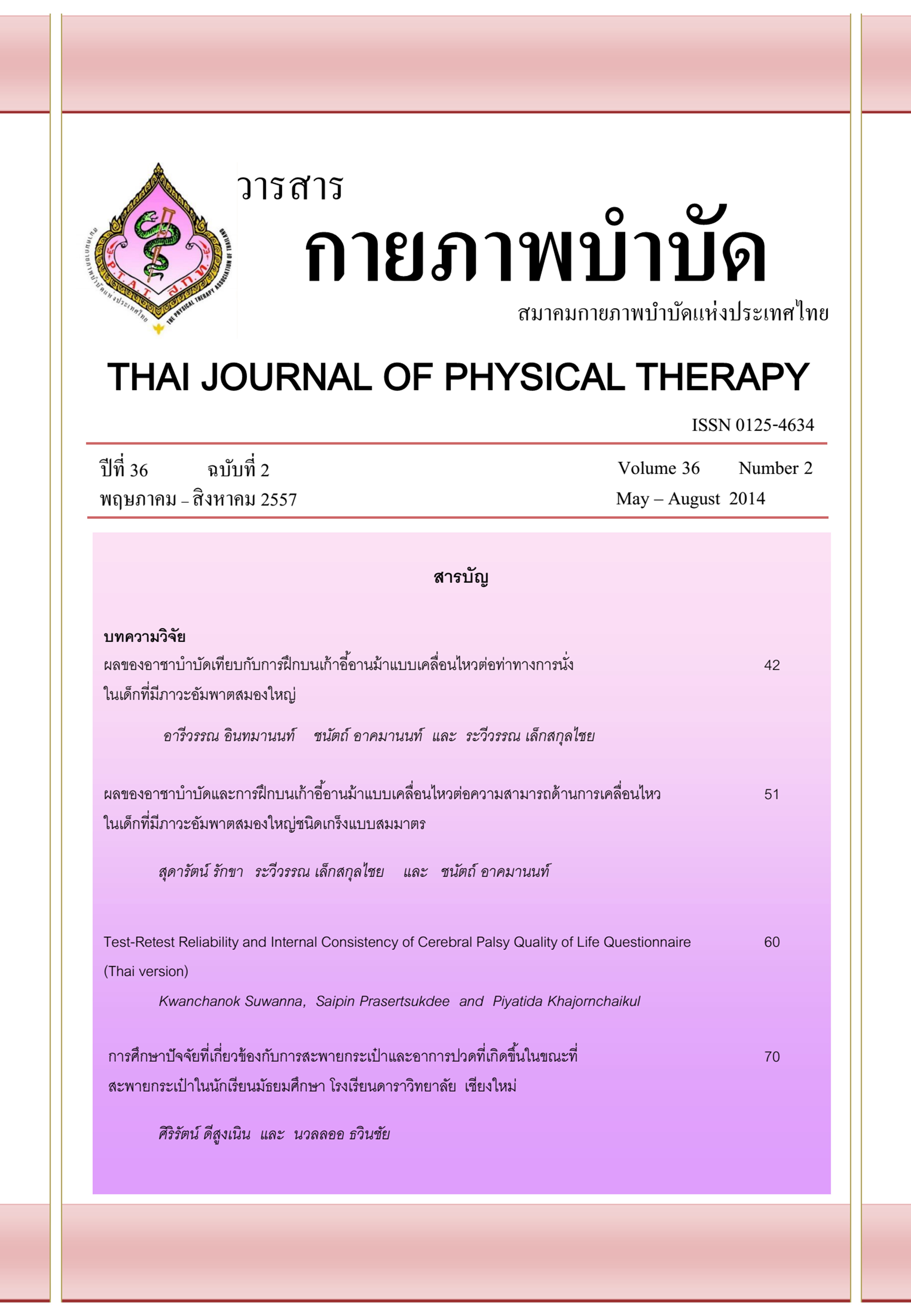ผลของอาชาบำบัดและการฝึกบนเก้าอี้อานม้าแบบเคลื่อนไหวต่อความสามารถด้านการเคลื่อนไหว ในเด็กที่มีภาวะอัมพาตสมองใหญ่ชนิดเกร็งแบบสมมาตร
Main Article Content
บทคัดย่อ
งานวิจัยที่ผ่านมาได้มีการรายงานหลากหลายเทคนิคในการฝึกการเคลื่อนไหวอย่างหยาบในเด็กที่มีภาวะอัมพาตสมองใหญ่ อาชาบำบัด (HP) และการฝึกบนเก้าอี้อานม้าแบบเคลื่อนไหว (DS) ก็เป็นเทคนิคการฝึกที่ได้รับการพิสูจน์แล้วว่ามีประสิทธิภาพที่ดี แต่ยังไม่มีการศึกษาใดที่เปรียบเทียบผลที่ได้จากการฝึกสองเทคนิคเทียบกัน วัตถุประสงค์ของการศึกษานี้คือ เพื่อเปรียบเทียบผลของ HP เทียบกับ DS เป็นระยะเวลา 6 สัปดาห์ ต่อความสามารถด้านการเคลื่อนไหวในเด็กที่มีภาวะอัมพาตสมองใหญ่ชนิดเกร็ง โดยผู้เข้าร่วมวิจัยจำนวน 10 คน ถูกสุ่มให้อยู่ในกลุ่มที่ได้รับการฝึกด้วย HP หรือ DS เด็กทุกคนได้รับการประเมินความสามารถด้านการเคลื่อนไหวจำนวน 3 ครั้ง คือ ครั้งที่ 1 ก่อนการฝึก ครั้งที่ 2 ที่สัปดาห์ที่ 3 และครั้งที่ 3 ที่สัปดาห์ที่ 6 ของการฝึก จากการวิเคราะห์ข้อมูล พบว่าทั้งสองกลุ่มมีการเพิ่มขึ้นของความสามารถด้านการเคลื่อนไหวอย่างมีนัยสำคัญทางสถิติในทุกท่าของการประเมิน เมื่อเปรียบเทียบคะแนนระหว่างกลุ่ม พบว่าความสามารถในท่าเดินของสัปดาห์ที่ 3 ของสองกลุ่มมีความแตกต่างกันอย่างมีนัยสำคัญทางสถิติ และ ความสามารถด้านการเดิน และคะแนนรวมในสัปดาห์ที่ 6 ของทั้งสองกลุ่ม มีความแตกต่างกันอย่างมีนัยสำคัญทางสถิติ จึงสามารถสรุปได้ว่า HP และ DS สามารถเพิ่มความสามารถด้านการเคลื่อนไหวในเด็กที่มีภาวะอัมพาตสมองใหญ่ชนิดเกร็งได้ แต่ HP มีประสิทธิภาพในการเพิ่มความสามารถด้านการเดินที่ดี
Article Details
เอกสารอ้างอิง
2. Hanna SE, Rosenbaum PL, Bartlett DJ. et al. Stability and decline in gross motor function among children and youth with cerebral palsy aged 2 to 21 years. Dev Med Child Neurol 2009; 51:295-302.
3. Rosenbaum P, Paneth N, Leviton A. et al. The definition and classification of cerebral palsy. Dev Med Child Neurol 2007; 49: 8-14.
4. Granados AC, Agis IF. Why children with special needs feel better with hippotherapy sessions: a conceptual
review. J Altern Complement Med 2011; 17: 191-7.
5. Casady RL, Nichols-Larsen DS. The Effect of Hippotherapy on Ten Children with Cerebral Palsy. Pediatr Phys Ther 2004; 16 :165-72.
6. Sterba JA. Does horseback riding therapy or therapist‐directed hippotherapy rehabilitate children with cerebral palsy? Dev Med Child Neurol 2007; 49: 68-73.
7. McGibbon NH, Benda W, Duncan BR et al. Immediate and long-term effects of hippotherapy on symmetry of adductor muscle activity and functional ability in children with spastic cerebral palsy. Arch Phys Med Rehabil 2009; 90: 966-74.
8. Quint C, Toomey M. Powered Saddle and Pelvic Mobility: An investigation into the effects on pelvic mobility of children with cerebral palsy of a powered saddle which imitates the movements of a walking horse. Physiotherapy 1998; 84: 376-84
9. Pope PM, Bowes CE, Booth E. Postural control in sitting the SAM system: evaluation of use over three years. Dev Med Child Neurol 1994; 36: 241-52.
10. Temcharuensuk P. Effect of dynamic saddle riding on sitting ability and gross motor performance in children with cerebral palsy [PhD Dissertation]. Bangkok: Mahidol University, 2013.
11. Russell D, Rosenbaum P, Gowland C et al. Gross Motor Function Measure Manual. Hamilton: McMaster University, 1993.
12. Silkwood-Sherer DJ, Killian CB, Long TM, Martin KS. Hippotherapy—An Intervention to Habilitate Balance Deficits in Children With Movement Disorders: A Clinical Trial. Phys Ther 2012; 92(5):707-17.
13. Encheff JL, Armstrong C, Masterson M. et al. Hippotherapy effects on trunk, pelvic, and hip motion during ambulation in children with neurological impairments. Pediatr Phys Ther 2012; 24: 242-50.
14. Kwon JY, Chang HJ, Lee JY et al. Effects of hippotherapy on gait parameters in children with bilateral spastic cerebral palsy. Arch Phys Med Rehab 2011; 92: 774-9.


